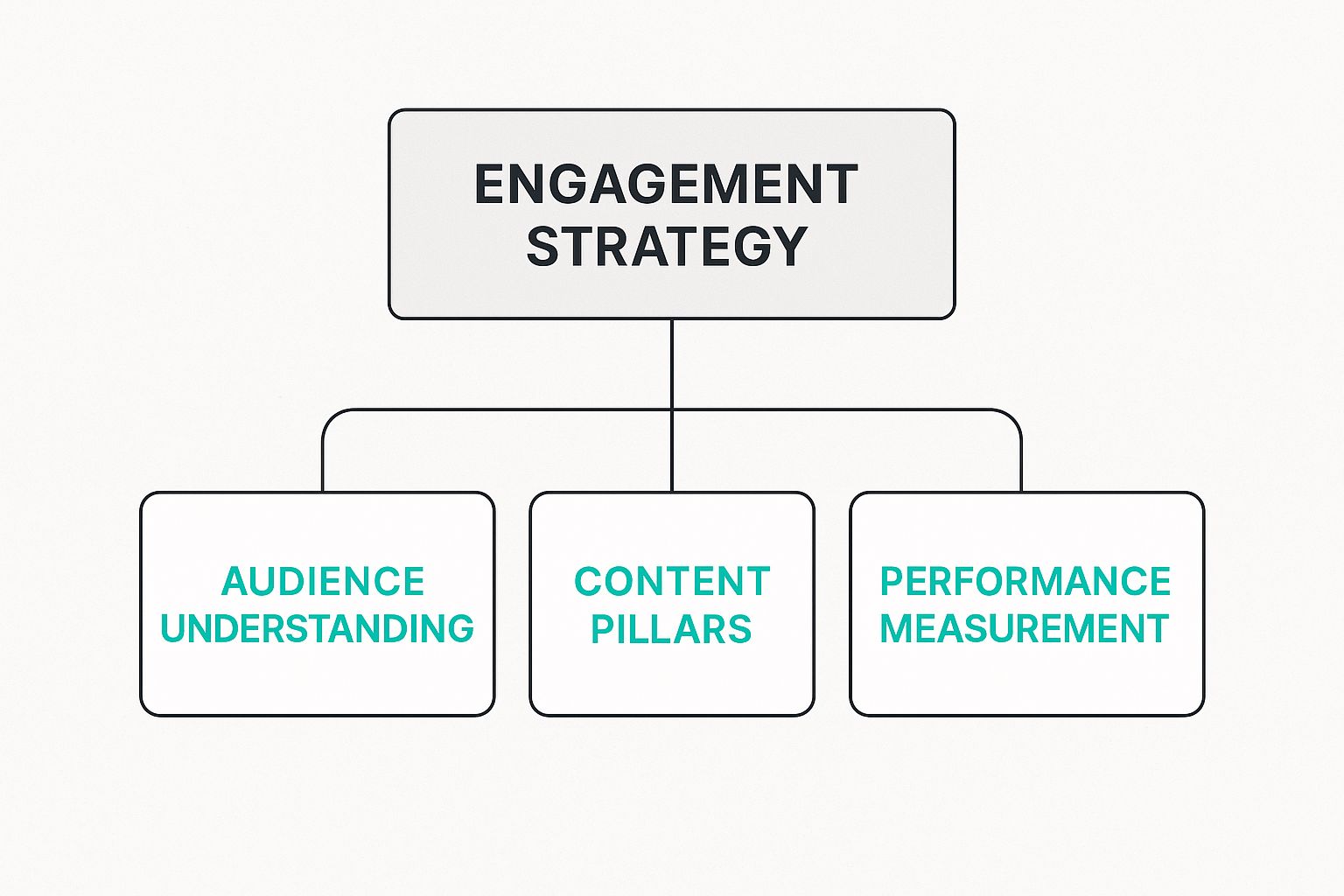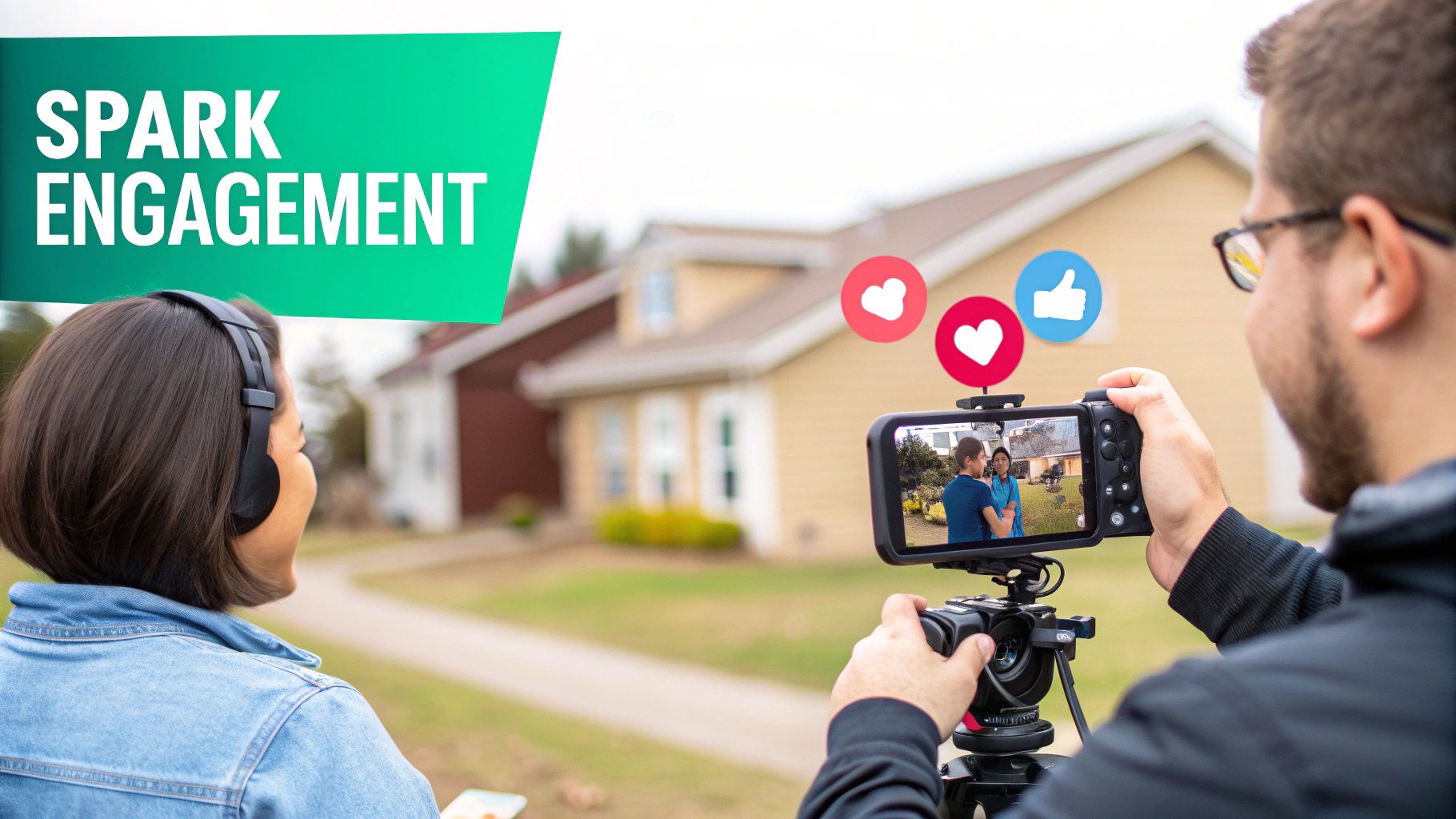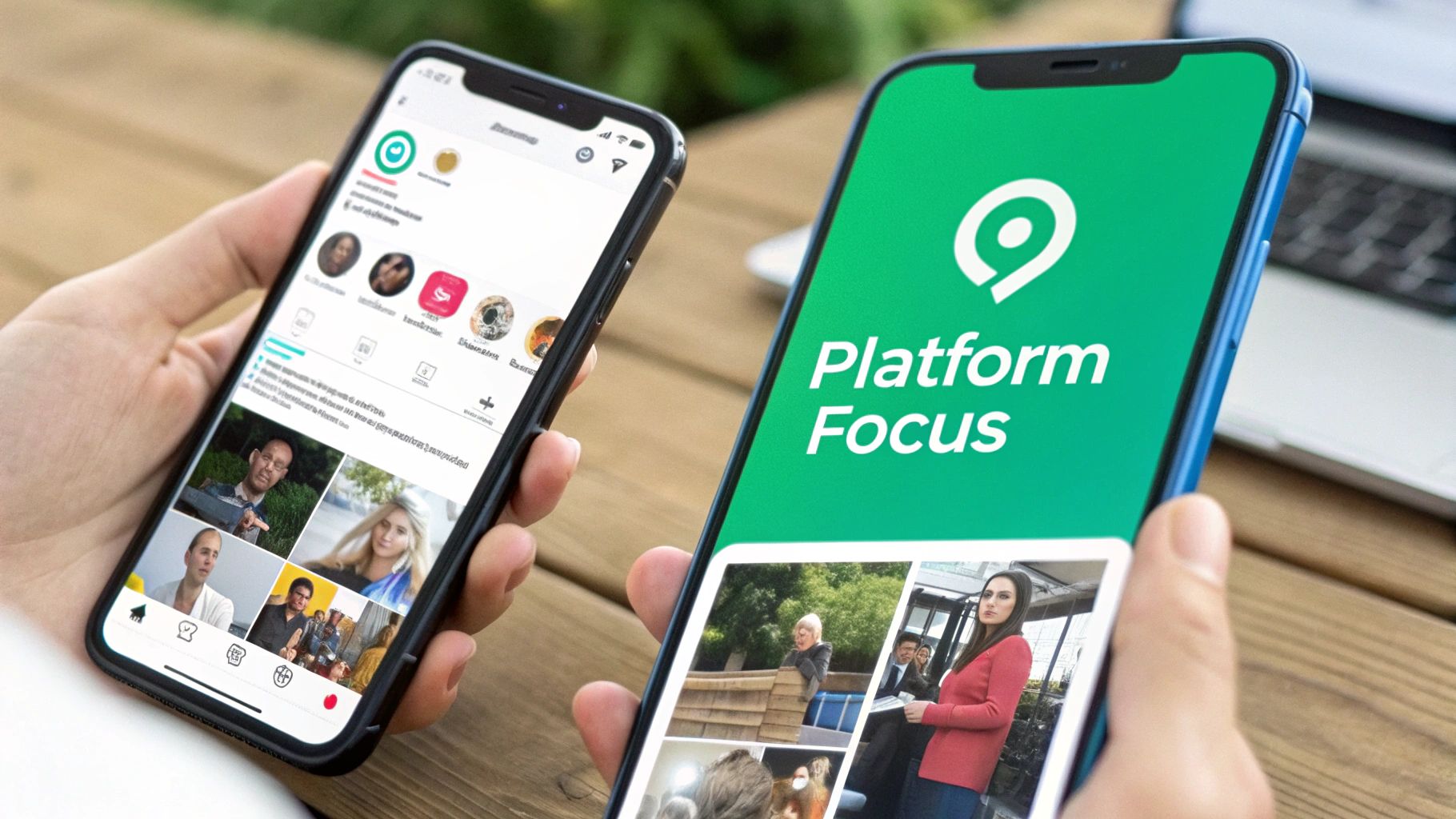A Winning Social Media Engagement Strategy
A social media engagement strategy is your playbook for how you’ll talk with your audience, not just at them. It’s the difference between throwing a party and just standing on a stage shouting announcements. The goal isn’t just to post; it’s to spark real, two-way conversations that build a loyal community.
This is how you turn passive scrollers into people who genuinely care about your brand.
Why an Engagement Strategy Is Non-Negotiable

Just having a social media account is like opening a shop but ignoring every customer who walks through the door. Pushing out content without a plan to interact is like shouting into a void. An engagement strategy flips that, turning your profiles from empty broadcast channels into lively community hubs where people actually want to hang out.
In a world drowning in content, genuine interaction is what makes a brand stick. When you take the time to reply to comments, ask questions, or share something a customer created, you’re showing people they’re more than just a number on a dashboard. That’s how you build real trust.
From Broadcast to Community Hub
Think about the sheer scale here. A smart engagement plan lets you tap into a massive global audience and build a tribe of loyal followers. It's an incredible opportunity to listen, learn, and tweak your approach based on direct feedback from the people who actually buy your stuff.
This direct line to your audience offers some serious business perks:
- Boosts Brand Loyalty: When customers feel seen and heard, they stick around. Those small, positive interactions build an emotional connection that a one-off purchase never could.
- Earns Customer Trust: Being transparent and responsive shows you’re the real deal. Answering questions and handling concerns out in the open proves you stand behind what you sell.
- Fuels Business Growth: Engaged followers are way more likely to become customers. And happy customers? They become your best marketers, spreading the word through shares and positive reviews.
A strong engagement strategy isn't just another item on a marketing checklist; it's a core business function. It directly shapes how people see your brand, keeps customers coming back, and drives revenue by turning a passive audience into an invested community.
The Scale of the Digital Conversation
The need for a solid engagement strategy gets even clearer when you look at the numbers. As of July 2025, there are 5.41 billion people on social media—that’s 65.7% of the entire world population. That number grew by 241 million in the last year alone, meaning the digital town square is only getting bigger.
Your customers are already online, talking about their problems, needs, and what they want from brands like yours. Without a strategy, you’re missing out on joining those conversations and, more importantly, shaping the story around your own brand. To get a head start, you can explore proven strategies to improve social media engagement and put these ideas into practice.
The old "spray and pray" method of just posting content is dead. Success today requires a much smarter, more human approach, which is a lot like understanding https://intently.ai/blog/why-cold-outreach-doesn't-work-anymore—it’s all about building genuine connections, not just shouting into the void.
Building The Four Pillars Of Your Strategy
A high-impact social media engagement strategy isn't built on random acts of posting. Much like a house, it needs a solid foundation to stand firm and support growth. This foundation rests on four essential pillars, each one critical for constructing a robust and sustainable engagement engine.
Without them, your efforts risk crumbling under the weight of audience indifference.
These components don't work in isolation; they’re all connected. A deep understanding of your audience informs the content you create. That content then guides how you manage your community. Finally, measuring performance tells you what's working so you can refine the entire process. It's a cycle.
Let's break down how to construct each pillar.
Pillar 1: Audience Understanding
Before you can engage anyone, you need to know who they are. This goes way beyond basic demographics like age and location. Real understanding means digging into the psychographics—their values, interests, pain points, and online behaviors.
What keeps them up at night? What kind of humor do they appreciate? Who else do they follow and interact with? Answering these questions lets you create content that feels like it was made just for them, sparking an immediate connection. Without this insight, you’re just guessing.
Pillar 2: Content That Connects
With a clear picture of your audience, you can start building out your content pillars. These are the core themes your brand will consistently talk about. Think of them as the main sections of a magazine; they give your feed structure and let your audience know exactly what to expect from you.
A balanced content mix should aim to:
- Educate: Offer genuinely helpful tips, how-to guides, or industry insights that solve a real problem for your audience.
- Entertain: Use humor, storytelling, or behind-the-scenes glimpses to show off your brand’s personality.
- Inspire: Share customer success stories, user-generated content, or motivational messages that align with your audience's values.
- Convert: Subtly guide followers toward an action, like visiting your site or signing up for a newsletter. Don’t be pushy.

As you can see, a successful strategy branches out from a core understanding of your audience. It directly influences both what you create and how you measure its success.
Pillar 3: Proactive Community Management
This is where the real magic happens. Community management is the active, two-way conversation that turns a list of followers into a genuine community. It involves both reactive and proactive tactics. Reactive management is simple: responding to comments, DMs, and mentions promptly and authentically.
Proactive management, though, is about starting conversations. It's asking questions, running polls, and encouraging people to share their own content. The best brands don't just wait for engagement to happen—they actively create opportunities for it.
Fostering a community isn't just about damage control or answering queries. It’s about creating a space where your audience feels valued and heard, making them more likely to become advocates for your brand.
Pillar 4: Meaningful Performance Measurement
Finally, you need to know if any of this is actually working. This pillar is about moving beyond vanity metrics like follower count and focusing on data that reflects a real connection. Are people just liking your posts, or are they saving and sharing them? Are your comments sections filled with actual conversations?
Here's what you should be tracking:
- Engagement Rate by Reach: This shows the percentage of people who actually saw your post and bothered to engage with it.
- Conversation Rate: This measures the number of comments per post, telling you how much discussion you're actually generating.
- Amplification Rate: This tracks shares per post, showing how many people are willing to vouch for your content.
This table provides a quick summary of how these four pillars come together to form a complete strategy.
The Four Pillars of an Engagement Strategy
| Pillar | Primary Goal | Key Activities |
|---|---|---|
| Audience Understanding | To deeply know who you're talking to. | Creating user personas, analyzing psychographics, social listening. |
| Content That Connects | To create posts that resonate and add value. | Developing content themes, mixing educational and entertaining formats. |
| Community Management | To turn followers into a loyal community. | Responding to comments, asking questions, encouraging user content. |
| Performance Measurement | To track what's working and refine the strategy. | Analyzing engagement rates, conversation rates, and share rates. |
Analyzing this data reveals what truly resonates, allowing you to double down on what works and ditch what doesn't. If you want to go even deeper, check out these 10 advanced social media engagement strategies. This continuous feedback loop is what ensures your strategy evolves and gets better over time.
Creating Content That Sparks Conversation

With a solid strategy in place, it’s time to focus on what does the real heavy lifting: the content itself. This is where you shift from planning to doing, creating posts that people can’t help but interact with. It’s all about understanding the psychology of the scroll and making something that stops thumbs in their tracks.
The secret isn’t just chasing trends or blindly following the "video is king" mantra. The real magic happens when you trigger an emotional response, whether that’s humor, empathy, or pure curiosity. When your content makes people feel something, they’re far more likely to engage.
Writing Captions That Stop The Scroll
Your visuals might be what grab the initial attention, but it’s the caption that often seals the deal and gets a response. A generic, throwaway caption is a massive missed opportunity. Instead, treat every single one like a mini-story or a conversation starter.
Think about how you can hook the reader immediately. Lead with a bold statement, a relatable problem, or a question they can’t help but answer. The only job of the first sentence is to get them to read the second.
Here are a few practical tips for writing better captions:
- Ask Open-Ended Questions: Steer clear of simple "yes" or "no" questions. Instead of, "Do you like this?" try asking, "What's the one feature you'd add to this?"
- Tell a Story: Share a quick anecdote about a customer win, a behind-the-scenes moment, or a lesson you learned the hard way. Stories build an emotional bridge between you and your audience.
- Create a "Fill-in-the-Blank": This is a simple but surprisingly effective way to lower the barrier to engagement. For example: "My go-to productivity hack is ______."
Your content is competing for attention against photos of friends, family, and cute pets. To win, you must provide value that's either deeply educational, genuinely entertaining, or incredibly inspiring. There is no middle ground.
Designing Visuals That Capture Attention
In a crowded feed, your visuals are your first impression. They need to be clear, compelling, and consistent with your brand identity. More than that, they need to have a purpose—whether that’s to educate, entertain, or drive a specific action.
Always consider the context of each platform. A polished infographic might crush it on LinkedIn, while a raw, unedited video clip could be the perfect fit for Instagram Stories. The key is matching the visual style to what the audience on that channel expects and wants to see.
This is more important than ever. Competition for attention is fierce, and brands are finding it tougher to earn those interactions. A 2025 analysis of over four million posts revealed some pretty significant year-over-year drops in engagement rates across the major platforms. Facebook’s rate fell by 36%, Instagram by 16%, TikTok by 34%, and X (formerly Twitter) saw the biggest plunge at 48%. To get a better sense of this shifting landscape, you can explore the full social media benchmark report.
Leveraging The Power Of User-Generated Content
One of the most powerful tools you have is user-generated content (UGC). This is any content—photos, videos, reviews, testimonials—created by your audience, not by you. Sharing UGC is the ultimate form of social proof; it shows real people loving and using your product.
Encouraging UGC also builds an incredible sense of community. When you feature a customer's post, you're not just getting free content. You're making that person feel seen and valued, which often inspires others to share their own experiences. It creates a positive feedback loop of authentic engagement.
Here’s a simple way to get more UGC flowing:
- Create a Branded Hashtag: Give your community a unique and easy-to-remember hashtag to rally around when they post about you.
- Run a Contest or Giveaway: Offer a real incentive for people to share photos or videos that feature your product.
- Just Ask: Sometimes, the simplest method is the best. Directly ask your followers to share their stories or photos in the comments or in their own posts.
When you focus on creating content that genuinely serves your audience, you transform your social media from a monologue into a lively, engaging dialogue that builds real, lasting relationships.
Choosing the Right Platforms to Win

One of the biggest mistakes you can make is trying to be everywhere at once. Spreading yourself across every social media platform is a surefire way to get burned out with very little to show for it. A winning social media engagement strategy isn’t about having a presence on every app; it’s about showing up in the right places.
Think of it like fishing. You wouldn’t just drop a line in any old pond and hope to catch a specific fish. You’d go to the river where you know that fish hangs out. It's the exact same idea here. Pouring your time and money into platforms where your audience isn't active is just plain inefficient.
Go Where Your Audience Lives
First things first: you have to figure out where your ideal customers are already spending their time. This needs to go deeper than just a gut feeling. If you're selling professional B2B software, you'll probably find a much warmer reception on LinkedIn than on TikTok. On the flip side, a fashion brand trying to reach Gen Z will almost certainly do better on Instagram and TikTok.
This is where all that audience research you did earlier comes into play. Take a hard look at the demographics and online habits of your ideal customer and match them to the user base of each platform. Where are they already going for advice, entertainment, or to connect with a community? Be there.
Align Platforms With Your Content Strengths
Every brand is better at creating certain types of content. Maybe your team is fantastic at producing slick, high-quality videos. If so, YouTube and Instagram should be at the top of your list. Or perhaps your strength is in writing insightful, long-form articles that break down industry trends. In that case, LinkedIn is your stage.
Don't try to force a content style that doesn't feel natural just to be on a trendy platform. It creates a disconnect, and your audience will feel it. The result is usually subpar content that nobody engages with. Instead, play to your strengths and pick the channels that let you shine.
- LinkedIn: The go-to for B2B companies, professional networking, and deep-dive educational content.
- Instagram & Pinterest: A must for visual-first brands in industries like fashion, food, travel, and home decor.
- TikTok: The king of short, fun, and trend-driven videos. Perfect for connecting with younger audiences.
- X (formerly Twitter): Unbeatable for real-time updates, breaking news, and jumping into public conversations.
Choosing the right platforms is about building a strategic portfolio. Each channel should have a clear purpose. You're not just blasting the same message everywhere; you're tailoring your communication to fit each platform's unique culture and what its users expect to see.
Today's user splits their attention across multiple apps, making this tailored approach more important than ever. A 2025 report found that the average person engages with 6.84 different social platforms each month. This just goes to show that a multi-platform presence needs to feel connected but also customized for each channel.
On top of that, social media is now a major discovery engine. In fact, 58% of consumers find new businesses there, which is more than traditional search engines. This means your platform choice has a direct line to how many new customers find you. To make the most of this, your content has to be built for the unique ways people discover things on each channel you're on. You can discover more insights about social media marketing statistics to help guide your decisions.
By focusing your energy on a handful of platforms where you can truly connect, you're setting yourself up for a social media strategy that is not only more effective but also sustainable for the long haul.
Using Social Listening to Sharpen Your Approach
Making great content is a huge part of the puzzle, but it’s not the whole picture. If you want your social media engagement strategy to go from good to truly great, you have to tune into the conversations that are already happening online. This is the art and science of social listening.
Think of it as digital eavesdropping, but for gathering killer business intelligence.
Instead of just waiting around for someone to tag you or mention your brand directly, social listening means you're actively seeking out conversations about your brand, your competitors, and your entire industry. It’s the difference between hearing someone shout your name in a crowded room and actually understanding the vibe of the whole crowd.
This approach gives you a direct line to raw, unfiltered insights from the people you want to reach.
Uncover Customer Pain Points and Opportunities
What are the real-world problems your customers are struggling with? Social listening lets you hear it straight from them, in their own words, instead of relying on guesswork. By keeping tabs on keywords related to your industry, you can spot common frustrations, wish-list features, and gaps in the market your competitors are overlooking.
This kind of information is pure gold. It’s a direct pipeline into your audience’s mindset, giving you a serious advantage. For a deeper dive, check out our article on effective social media reputation monitoring to see how listening can protect and build your brand.
The Rise of AI in Social Listening
Let's be real: trying to manually track every relevant conversation across Reddit, X, LinkedIn, and everywhere else is a surefire way to lose your mind. This is where AI-powered tools are completely changing the game. They automate the whole process, scanning millions of posts to find high-intent discussions as they happen.
But these advanced systems do more than just hunt for keywords. They analyze the sentiment behind a post—is the person happy, frustrated, or just neutral? They can also identify urgency, helping you figure out which conversations to jump into first. This moves your strategy from being purely reactive to something that feels predictive and deeply personal.
For instance, a tool might flag a post where a developer is complaining about a specific bug that your software fixes. This lets you swoop in with a helpful solution before they even knew you existed.
This screenshot shows how a platform like Intently can spot high-intent conversations and surface qualified leads right from social media channels.
By making sense of the sentiment and context, these tools turn the chaotic noise of social media into a clean, prioritized list of real engagement opportunities.
A Simple Workflow for Consistent Listening
You don't need a complicated system to integrate social listening into your work. A simple, three-step workflow can make it a consistent habit, keeping you plugged into the pulse of your audience and industry.
Here’s how you can get started:
Identify Your Keywords: First, brainstorm a list of key terms you want to monitor. This list should include your brand name, product names, your competitors' names, and wider industry topics. Try to think about the exact phrases a potential customer would use when searching for a solution like yours.
Set Up Your Monitoring Tools: Pick a social listening tool that fits your needs and budget. Set it up to track your keywords across the platforms where your audience spends their time. You can also configure real-time alerts for high-priority terms (like your brand name) and have them sent straight to your email or Slack.
Analyze and Act on Insights: Carve out some time each week to go through the conversations your tool has picked up. Look for trends, spot common questions, and pinpoint opportunities to jump in and engage. Use what you find to shape your content calendar, tweak your messaging, and even give feedback to your product team.
Social listening transforms your engagement strategy from a guessing game into a data-informed science. It allows you to meet your audience where they are, armed with the context needed to build genuine connections and solve real problems.
Turning Engagement Data into Smarter Decisions
So, you’re creating great content and getting conversations started. Awesome. But that’s only half the battle. The final, most important piece of any social media engagement strategy is turning all that activity into actual intelligence that helps you grow. If you skip this step, you’re basically just guessing.
It’s way too easy to get lost in a sea of numbers, especially "vanity metrics" like follower counts. Real insight comes from digging into the key performance indicators (KPIs) that measure genuine connection. These are the numbers that cut through the noise and tell you how much your content actually resonates with people.
Focusing on Metrics That Matter
To really get what's going on, you have to look past the surface-level likes. The best metrics show you the quality of your engagement, not just the quantity. They tell a story about how your audience feels and what they do next.
Here are a few essential KPIs to keep on your radar:
- Engagement Rate by Reach: This is the ultimate test of your content's quality. It measures the percentage of people who saw your post and actually bothered to interact. A high rate here means you’re compelling enough to stop the scroll.
- Conversation Rate: This one’s simple: it’s the number of comments per post. It’s a direct line into how much discussion you’re creating, separating the passive likes from the active dialogue.
- Amplification Rate: This tracks the number of shares per post. It shows how many people thought your content was so valuable they were willing to put their own reputation on the line and share it with their network.
Moving from vanity metrics to meaningful KPIs is like switching from a blurry, old map to a high-definition GPS. It gives you the clarity to see exactly where you are, where you're going, and the best route to get there.
Creating a Continuous Feedback Loop
Data is completely useless if it just sits in a dashboard collecting digital dust. The goal is to create a continuous feedback loop where your analytics directly inform your next move. This means carving out time for regular, structured reviews of your performance so your strategy can evolve and get better.
A monthly strategy review is a fantastic place to start. During this meeting, don't just glance at the numbers—ask why they look the way they do. This is how you turn raw data into powerful insights that can sharpen your entire approach.
Asking the Right Questions
When you're doing your reviews, guide your analysis by asking specific, targeted questions. This framework helps you pinpoint exactly what’s driving your wins and where you have opportunities to improve.
Here are a few questions to get the ball rolling:
- Which content pillar drove the most shares this month? This helps you figure out which topics are your most valuable and share-worthy.
- What time of day consistently gets the highest conversation rate? This is a goldmine for optimizing your posting schedule to catch people when they're ready to chat.
- Which post formats (like carousels, videos, or text-only) had the best engagement rate by reach? This tells you exactly what your audience prefers to see and consume.
- Did any posts lead to a noticeable jump in website clicks or leads? This is how you connect your social media efforts directly to business outcomes. For a deeper look into this, our beginner's guide to B2B lead generation provides a solid framework.
By consistently looking at your data through this lens, you stop making guesses and start making informed, strategic decisions. This transforms your social media presence from a bunch of reactive tactics into a proactive, data-driven engine for growth.
Still Have Questions About Social Media Engagement?
Even the best plans run into a few snags. It's totally normal. Let’s tackle some of the most common questions that pop up when you're building out your social media engagement strategy.
What’s the Magic Number for Posting Frequency?
This is a classic question, and the answer is all about balance. Yes, you need to be consistent to stay on your audience's radar, but quality will always beat quantity. Flooding your followers' feeds with fluff is the quickest way to get an unfollow.
Instead of chasing a specific number, focus on creating content that actually helps or entertains your audience. It's far better to share three genuinely amazing posts a week than it is to push out seven that are just okay. Dig into your analytics, find out when your people are most active, and save your best stuff for those peak times.
A great social media engagement strategy isn't about how often you post, but how often you post something that your audience actually cares about.
How Should I Deal With Negative Comments?
First thing's first: don't panic. And definitely don't just delete it. Facing negative feedback head-on shows everyone you’re transparent and, more importantly, that you listen. Try to respond quickly and professionally, always leading with empathy for their frustration.
Whenever you can, offer to move the conversation to a private channel like DMs or email to sort out the specifics. This approach not only helps fix the immediate problem for that customer but also shows your entire audience that you take customer service seriously. You can actually turn a negative into a huge positive.
Which Engagement Metrics Actually Matter?
It’s time to look past the vanity metrics like likes and follower counts. If you want to get a real feel for the health of your social media engagement, you need to track the metrics that show a genuine connection with your audience.
Here are the three essential KPIs you should be watching:
- Engagement Rate by Reach: This tells you the percentage of people who saw your post and actually interacted with it.
- Conversation Rate: This one’s all about the comments per post, giving you a clear signal of how much active discussion you're sparking.
- Amplification Rate: This tracks your shares, showing you what content your audience found valuable enough to pass on to their own networks.
Ready to stop guessing and start finding high-intent customers on social media? Intently uses AI to monitor conversations across Reddit, X, and LinkedIn, delivering qualified leads directly to you. Discover how Intently can sharpen your outreach today.
